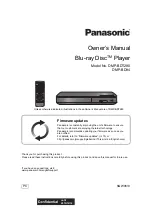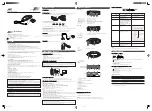
IC Descriptions.
GB 46
ASD-1
9.
–
Defect detector: Holds the focus and/or radial control
signal on disc dropouts.
–
Speed control: Used during access. With radial actuator
feed forward.
–
Focus control: PID controller with wide range adjustable
characteristics.
–
Radial control: PID controller with wide range adjustable
characteristics.
–
Sledge control: PID controller with wide range adjustable
characteristics and a pulsed sledge controller.
–
Laser Low Power: Switches the laser from write back to
read power whenever the device tends to go off-track.
9.5
Input circuits servo
Five out of six of the MACE2 servo inputs can be switched
between diode current inputs (for audio and data application)
and error signal inputs (for recordable applications).
The analogue signals from the diode pre processor are
converted into a digital representation using A/D converters.
9.6
Focus control.
9.6.1
Focus start-up.
To bring the actuator in focus position a triangular shaped
voltage is applied to the actuator to perform a search
movement. When the lens moves from or to the disc, CA
(central aperture) is monitored to reach a certain
programmable absolute level. When this value is CA level is
reached, the FOK signal becomes true and FEn is passed to
the FEn level detector.
At the moment this FEn level is reached the wait for the focus
mode is entered and the focus control loop is enabled to
detect a sign inversion in the FEn signal.
When this zero crossing in this FEn signal is detected, the
loop is closed to function as PID controlled loop and is
switched to the PID mode.
During focus start-up a dither signal is added to the output
signal of the integrator. It prevents the actuator from hitting its
natural resonance. With this technique quantisation, effects
are compensated for during start-up.
9.6.2
Focus Position Control loop.
The focus control loop contains a digital PID controller that
has 5 parameters available to the user. These coefficients
influence the integrating, proportional and differential action
of this PID and a digital low pass filter following the PID. The
fifth coefficient influences the loop gain.
9.6.3
Dropout detection.
This detector can be influenced by one parameter. The FOK
signal will become false and the integrator of the PID will hold
if the CA signal drops below this programmable absolute CA
level. When the FOK signal becomes false, it is assumed as
caused by a black dot in the first place.
9.6.4
Focus Loss detection and Fast restart.
Whenever FOK is false longer than about 2 ms, it is assumed
that the focus point is lost. A fast restart procedure is initiated
which is capable of restarting the focus loop within 200 to 300
ms depending on the uP-programmed coefficients.
9.6.5
Focus Automatic Gain Control loop.
The loop gain of the focus control loop can be corrected
automatically to eliminate tolerances in the focus loop. This
gain control injects a signal into the loop that is used to
correct the loop gain. Since this decreases the optimal
performance, the gain control should only activated shortly
(for instance when starting a new disc).
9.7
Radial control.
The MACE2 digital controller includes the following radial
servo functions:
9.7.1
Level initialisation:
During start-up an automatic adjustment procedure is
activated to set the values of the radial error gain, offset and
satellite sum/MIRN signal gain for TPI level generation. The
initialisation procedure runs in a radial open loop situation
and is < 200 ms. This start-up time period may coincide with
the last part of the turntable motor start-up time period.
9.7.2
Automatic gain adjustment:
Because of this initialisation the amplitude of the RE signal is
adjusted within _10% around the nominal RE amplitude.
Offset adjustment: The additional offset in RE due to the
limited accuracy of the start-up procedure is less than +/-
50nm.
9.7.3
TPI level generation:
The accuracy of the initialisation procedure is such that the
duty cycle range of TPI becomes 0.4 < duty cycle < 0.6.
Sledge home:
Sledge moves to reference position at the inner side of the
disc with user defined voltage.
Tracking control:
The actuator is controlled using a PID loop filter with user
defined coefficients.
Access:
In Mace2 there are two fundamentally different ways to
perform an access:
Using the PCS
A more detailed description of this access method is given in
an other section.
Using the servo controlled access:
The way it was done in the predecessors of Mace2.This
access procedure is divided into 3 different modes,
depending on the requested jump size:
access type size access speed
Actuator jump decreasing velocity
Sledge jump maximum power to sledge 1
Controlled sl. jump controlled brake power
The access procedure makes use of a track counting
mechanism, a velocity signal based upon the number of
tracks passed within a fixed time interval, a velocity setpoint
calculated from the number of tracks to go and a user
programmable parameter indicating the maximum sledge
performance.
If the number of tracks to jump is too large, then the Sledge
jump mode is activated, else the actuator jump is performed.
The requested jump size together with the required sledge
braking distance at maximum access speed defines the
value of the maximum numbers of tracks.
During the actuator jump mode, velocity control with a PI
controller is used for the actuator. The sledge is then
continuously controlled using the filtered value of the
integrator contents of the actuator. All filter parameters (for
actuator and sledge) are user programmable.
Summary of Contents for DV4100F
Page 20: ...25 26 Display PWB ...
Page 25: ...35 36 A V Mux panel N1B _Z _A ...
Page 29: ...43 44 A V Pwb A1B S1G U1B ...
Page 30: ...45 46 A V Pwb A1B S1G U1B ...
Page 63: ...Directions for use GB 6 ASD 1 3 3 Directions for use There is no DFU available ...
Page 95: ...38 ASD 1 7 Electrical diagrams and PWB s Detailed Top view 1 CL06532065_045 eps 180500 ...
Page 96: ...Electrical diagrams and PWB s 39 ASD 1 7 Detailed Top view 2 CL06532065_046 eps 180500 ...
Page 97: ...40 ASD 1 7 Electrical diagrams and PWB s Bottom view CL06532065_047 eps 180500 ...
Page 98: ...Electrical diagrams and PWB s 41 ASD 1 7 Detailed Bottom view 1 CL06532065_048 eps 180500 ...
Page 99: ...42 ASD 1 7 Electrical diagrams and PWB s Detailed Bottom view 2 CL06532065_049 eps 180500 ...
Page 101: ...44 ASD 1 7 Electrical diagrams and PWB s Personal notes Personal notes ...
















































